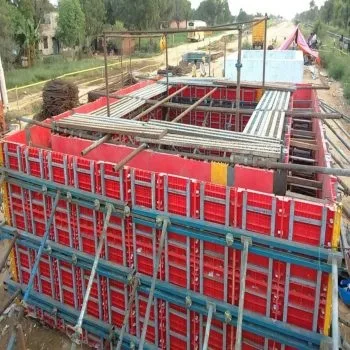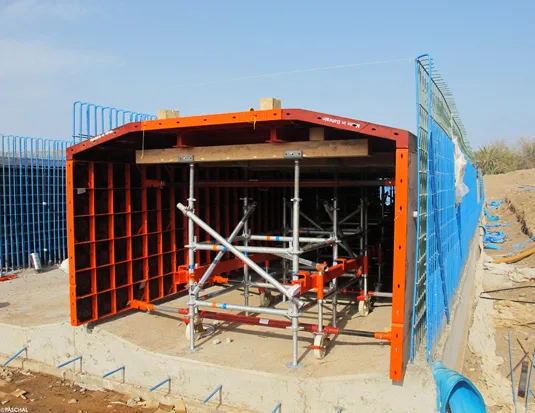Box culvert formwork is a temporary mold or structure used in the construction of box culverts, which are reinforced concrete structures commonly used for the passage of water or other materials beneath roadways, railways etc.
What are box culverts?
Box culverts are rectangular structures with four sides, a base, and a top, typically used to facilitate the flow of water, passage of utilities, or support transportation infrastructure.
How formwork is used?
The formwork is designed to create the desired shape and dimensions of the box culvert during the concrete pouring and curing process. Typically made of wood, steel, or other durable materials, the formwork provides a framework for the concrete, ensuring it takes the intended shape and structure. Precise and well-designed formwork is essential for achieving the desired strength, durability, and dimensional accuracy of the box culvert. The formwork is assembled before concrete placement, and once the concrete has cured, it is removed, leaving behind the completed box culvert structure.

Here’s how it works:
- Mold Creation: Box culvert formwork is designed to create the specific dimensions and shape required for the culvert. It acts as a mold into which concrete will be poured.
- Reinforcement Placement: Within the formwork, steel reinforcement, such as bars or mesh, is placed. This reinforcement adds strength to the concrete structure and helps it withstand various loads and stresses.
- Concrete Pouring: Once the formwork is in place and the reinforcement is set, concrete is poured into the mold. The formwork contains and shapes the concrete, ensuring it takes on the desired configuration.
- Curing: After the concrete is poured, it undergoes a curing process to gain strength. The formwork supports the concrete during this critical phase, preventing deformities and ensuring the structural integrity of the culvert.
- Formwork Removal: Once the concrete has cured sufficiently, the formwork is carefully removed. This reveals the finished box culvert structure.
Advantages of box culvert formwork
- Shape and Dimensional Accuracy: Formwork ensures that box culverts are molded with precision, adhering to specific dimensions and shapes outlined in engineering and design plans.
- Structural Stability: The formwork provides a temporary mold that supports the concrete as it cures, contributing to the overall structural stability and integrity of the box culvert.
- Efficient Construction: By using formwork, construction processes become more efficient. Precast elements can be manufactured off-site, reducing on-site construction time and potential disruptions.
- Quality Control: Formwork allows for strict quality control measures during the construction process, ensuring that the box culvert meets required standards for strength, durability, and safety.
- Cost-Effectiveness: Despite the initial investment in formwork, the overall cost can be lower due to increased efficiency, reduced labor requirements, and minimized material wastage during construction.
- Design Flexibility: Formwork can be customized to accommodate various sizes and shapes, providing flexibility in design to meet specific project requirements.
- Consistent Surface Finish: Formwork contributes to achieving a consistent and smooth finish on the concrete surface, enhancing the overall aesthetics of the box culvert.
- Repeatability and Reusability: Formwork systems can be reused for multiple units of box culverts, particularly in projects with similar specifications, improving cost-effectiveness and minimizing material consumption
Types of box culvert formworks
Precast Box Culvert Formwork: Precast box culvert formwork involves the manufacturing of culvert sections off-site in controlled environments. The formwork is meticulously crafted to create precise molds for the culvert segments. These precast sections are then transported to the construction site, where they are efficiently assembled. This method offers advantages such as streamlined production in a controlled environment, ensuring consistently high-quality sections and accelerating on-site assembly.
Modular Box Culvert Formwork: Modular formwork for box culverts involves the use of prefabricated, standardized units that can be assembled in various configurations to create the mold for the culvert. This method enhances versatility in design, speeds up the assembly process through the use of standardized components, and often offers the potential for reusability, making it a practical choice for projects with varied design requirements.
Slipform Box Culvert Formwork: Slipforming is a continuous construction method where the formwork moves gradually as concrete is continuously poured, allowing for the construction of long, uninterrupted structures like box culverts. This technique proves efficient for large-scale projects, ensuring continuous construction without the need for joints, and has the potential to increase overall construction speed. The choice of box culvert formwork depends on the unique requirements of the construction project, considering factors such as efficiency, cost-effectiveness, and the desired level of customization.
Cast-in-Place Box Culvert Formwork: Cast-in-place box culvert formwork involves the creation of formwork on-site, where the mold for the culvert is assembled, and concrete is poured directly into it. Once the concrete has set and gained sufficient strength, the formwork is dismantled and removed, leaving behind the cured box culvert. This method offers flexibility in adapting to site-specific requirements but requires additional labor for formwork assembly and removal.
Stay-in-Place Box Culvert Formwork: Stay-in-place box culvert formwork refers to a construction method where the formwork used to shape the culvert remains in place as a permanent part of the structure. The formwork is designed to contribute to the structural integrity of the culvert and eliminates the need for removing the formwork after the concrete has set. This approach is often chosen for projects where a permanent, durable structure is desired, and it can lead to time and cost savings by avoiding the removal and disposal of temporary formwork.

How to select the right box culvert type?
Selecting the right box culvert involves considering various factors to ensure it meets the specific requirements of your project. Here’s a systematic approach:
1. Project Requirements:
- Identify the purpose of the box culvert, whether it’s for drainage, pedestrian passage, or vehicular traffic.
- Determine the flow capacity needed based on the expected water volume or traffic load.
2. Regulatory Compliance:
- Ensure compliance with local building codes, standards, and regulations.
- Check if there are specific requirements for load-bearing capacity, material specifications, and environmental considerations.
3. Site Conditions:
- Evaluate the site conditions, including soil type, groundwater levels, and any potential environmental impact.
- Consider the impact of seismic activity or flooding on the culvert design.
4. Hydraulic Analysis:
- Perform a hydraulic analysis to determine the appropriate size of the culvert based on expected flow rates and water levels.
- Consider factors like velocity, headwater, and tailwater conditions during different weather events.
5. Material Selection:
- Choose a material for the box culvert based on the specific project requirements. Common materials include concrete, steel, or high-density polyethylene (HDPE).
- Consider factors such as durability, corrosion resistance, and maintenance requirements.
6. Load-Bearing Capacity:
- Assess the load-bearing requirements based on the intended use of the culvert (e.g., vehicular traffic, pedestrian loads).
- Ensure that the chosen culvert design can withstand the expected loads without compromising structural integrity.
7. Installation and Maintenance:
- Consider the ease of installation and maintenance. Some materials or pre-engineered systems may offer quicker installation, reducing overall project time.
- Evaluate the long-term maintenance requirements and choose a culvert that aligns with available resources.
8. Budget Constraints:
- Assess the project budget and consider the initial cost, as well as potential long-term savings in terms of maintenance and durability.
- Compare the costs of different materials and construction methods.
9. Future Expansion or Alterations:
- Anticipate future needs and assess if the selected box culvert allows for expansion or modifications.
- Consider the flexibility of the chosen material and design for accommodating changes in traffic patterns or water flow.
10. Consultation with Experts:
- Seek advice from civil engineers, geotechnical experts, and other professionals who specialize in culvert design and construction.
By carefully considering these factors, you can make an informed decision when selecting the right box culvert for your project, ensuring it aligns with safety standards, environmental considerations, and long-term functionality.

Applications of box culvert formwork
1. Drainage Systems: Box culverts are commonly used in drainage systems to control the flow of water beneath roads, railways, or other structures.
2. Underpasses: In transportation infrastructure, box culverts often serve as underpasses, allowing roads or pathways to pass over watercourses, ensuring uninterrupted traffic flow.
3. Stormwater Management: Box culverts are used in stormwater management systems to control the flow of rainwater and prevent flooding..
4. Tunnels: In some cases, box culverts are used as components of tunnel systems, providing passages for utilities or water conveyance.
5. Utility Crossings: Box culverts may be used for utility crossings, allowing the passage of pipes, cables, or other infrastructure beneath roads or railways.
6. Bridge Abutments: Box culverts can be integrated into bridge abutments to facilitate water flow or provide drainage solutions
7. Stream Crossings: Box culverts are used for stream crossings, providing pathways for watercourses beneath roads or trails. Conclusion
Conclusion
Efficient and precise box culvert formwork is crucial for the successful construction of durable and structurally sound infrastructure. The use of advanced formwork technologies not only accelerates the construction process but also ensures the precision and uniformity of the box culvert components. Properly designed formwork systems contribute significantly to cost savings, reduced construction time, and overall project success. As infrastructure demands continue to grow, optimizing box culvert formwork processes will play a pivotal role in meeting these challenges effectively and sustainably.
Image Source: paschalindia.com/english/, novaformworks.com, alsina.com/in/



